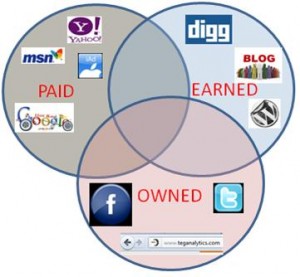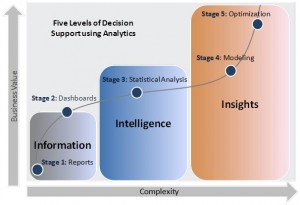 Digital advertising is increasing in importance, even for heavy users of traditional media like CPG firms. Among TEG clients, we are seeing upto 1% of revenue being allocated for digital advertising. Consequently management is asking questions of the digital marketing group, about the tangible being generated. These are still early days, and most companies are still years away from getting true ROI numbers and optimizing digital spend, taking cross channel impacts into account. Mostly, our clients are deciding on the KPIs that are relevant & meaningful, and on the mechanisms that need to be set up to track & measure them.
Digital advertising is increasing in importance, even for heavy users of traditional media like CPG firms. Among TEG clients, we are seeing upto 1% of revenue being allocated for digital advertising. Consequently management is asking questions of the digital marketing group, about the tangible being generated. These are still early days, and most companies are still years away from getting true ROI numbers and optimizing digital spend, taking cross channel impacts into account. Mostly, our clients are deciding on the KPIs that are relevant & meaningful, and on the mechanisms that need to be set up to track & measure them.
 Before moving into the details, it is important to understand the key components of online marketing. Broadly, all online marketing channels are divided into 3 overarching categories , Paid, Owned & Earned. The definition first came into public domain in March of 2009, when Dan Goodall of Nokia, wrote in his blog about Nokia’s digital marketing strategy.[1]
Before moving into the details, it is important to understand the key components of online marketing. Broadly, all online marketing channels are divided into 3 overarching categories , Paid, Owned & Earned. The definition first came into public domain in March of 2009, when Dan Goodall of Nokia, wrote in his blog about Nokia’s digital marketing strategy.[1]
At a high level, paid is media you buy – you get total control over messaging, reach and frequency, as much as your budget allows; earned is what others say about your brand – you get no control but you can influence outcomes if you’re smart; and owned is content you create – you control the messaging, but not so much whether anyone reads/views it.
Evaluating the impact of your digital strategy
 Evaluation of the ‘true impact’ of your digital marketing strategy & spend, is a multi-phase journey. At TEG Analytics, we break the journey into five distinct phases
Evaluation of the ‘true impact’ of your digital marketing strategy & spend, is a multi-phase journey. At TEG Analytics, we break the journey into five distinct phases
- Datawarehousing & Reporting : Get all your digital data under one roof
- Dashboarding : Identify KPIs and interactions and create meaningful dashboards
- Statistical Analysis: Determine the past impact on business KPIs like Sales, Profit etc from your Marketing inputs. This utilises Market & Media Mix modelling techniques
- Predictive Analysis: Use historical analysis to identify likely future scenarios for your business
- Optimization: Use inputs from predictive analysis to run an optimal marketing strategy by maximising ROI subject to budgetary constraints
To begin with, one needs to decide what impact is desired from each digital channel e.g. e-mail campaigns should get my new customers to sign up on my site. This will easily lead us to the KPI that needs to be tracked on an ongoing basis, and any industry research can provide us the relevant benchmarks. The rest of the article shall focus on those metrics that TEG Analytics believes need to be captured & tracked to get a holistic & detailed understanding of digital marketing performance. These metrics have been arrived at from numerous projects in digital analytics that TEG Analytics has completed for clients across the globe.
Paid Media
Display Banner Advertising
Display Banners typically account for a lion’s share (40-55%) of digital advertising budget, based on TEG Analytics’ experience.[2]
The intention of display banner advertising is to drive traffic to our own website & also to create brand awareness. To determine if the strategy is working to deliver these goals , TEG Analytics recommends that all advertisers should track the following metrics
- Impressions: This is an exposure metric that counts how many time an ad was shown
- Clicks: Response to an ad measured through clicks
- Click-rate: Clicks as % of impressions. Click-rate is declining in the industry as consumers tend to prefer getting all the relevant information within the banner itself.
- Rich media interactions: Is a counter of all interactions that take place within the rich media unit (e.g. expanding, clicking within the multiple parts of banner etc.)
- Floodlight Metrics: This is a Doubleclick[3] specific term and is used to track actions that visitors take once they arrive on the website. Each campaign and brand may track specific actions on site so there could be many floodlight metrics across all brands.
Paid Search
Paid Search also known as Search Engine Marketing is used by advertisers to show relevant ads on Search Engines. Paid Search typically accounts for around 10 – 15% of the total digital advertising budget.
Paid Search is primarily intended to drive traffic to owned websites, and e-commerce links to induce purchase. TEG Analytics recommends that the following KPIs should be tracked and measured to evaluate paid search impact.
- Impressions: This is an exposure metric that counts how many time an ad was seen/shown
- Clicks: Response to an ad measured thru clicks
- Click-rate: Clicks as % of impressions.
- Cost per Click: The total spend on Paid Search divided by the total Clicks that the advertiser has got. It is factored in through the bid management tool that the agency handles.
- Average Position: Specific to search advertising. It shows where the ad shows up within the paid search results of a search engine result page. Industry best practice is to be on the top 3 spots. Anything after the top 3 means that the ad shows up on the right hand side of the page, where both visibility of and response to the ad are minimal.
Streaming TV
Streaming TV is streaming video execution done on a digital platform. When advertising videos are shown on websites such as abc.com, google.com or others it’s called Streaming TV. Simplistically speaking it is an extension of television viewership. As television viewership starts moving to the digital channels, advertisers are moving money from television to digital media.
Steaming TV accounts for around 15 – 20% of total digital advertising budget.
Streaming TV executions are typically bought on a CPM or Cost per Thousand Impressions basis which implies the payment is based on the exposure that the advertiser gets in the Streaming Video space. In some rare cases, Streaming TV can also be bought on Cost per Video View.
The desired actions from Streaming TV ads are very similar to TV advertising. TEG Analytics recommends our clients to track metrics that approximate to TRPs most closely.
- Video Impressions: This is an exposure metric that counts how many times the video ad was seen/shown
- Video Clicks: Response to the video ad measured thru clicks
- Companion Banner Impressions: This is an exposure metric that counts how many time a Companion Banner ad was seen/shown
- Companion Banner Clicks: Response to the display banner ad measured thru clicks
- Video Midpoint or 50% Completion Metric: People have viewed at least 50% of the video ad
Digital Coupons
Digital coupons are the online counterpart of regular print coupons and are heavily used by CPG and other Consumer Products marketers, as a price discounting medium. They account for approximately 2-5% of all digital advertising.
Coupons are essentially an extremely direct method of marketing, with a straight forward purpose of redemption by the customer. To ensure the redemption number being tracked is normalised across the size of the campaign itself, TEG Analytics recommends the redemptions be tracked as a proportion of prints. The KPIs that all coupon distributors should track are
- Prints – Total # of Coupons printed or Save 2 Card from the digital environment
- Redemptions – Number of printed Coupons Redeemed in store
- Redemption Rate – Number of redemptions divided by Print. All coupons have an expiration date. However due to lag between actual redemptions and retailers reporting the redemption numbers, redemptions will be seen trickling in even after the expiration date.
Owned Media
Company Websites
Company websites are one of the most often used media to communicate the company and brand vision to the customer. It is also used as a tool to enable e-commerce for the advertiser’s products. Most of digital marketing, ultimately induces the viewer to visit the company website, hence it probably is THE most important part of your digital armoury. Websites typically consume 10-15% of the digital marketing budget.
Google Analytics is typically used to track Website performance, and is highly recommended by TEG Analytics, as it has a very solid back end as well as evolved reporting interface. Google Analytics is a free online tool and there is no cost associated with implementing and using this system. On the flip side there is no direct customer support or customization possible.
TEG Analytics recommends that the advertiser extract and maintain multiple metrics for tracking website performance.
- Visits: A visit is a session that typically lasts for 30 minutes. After 30 minutes it would renew as a new session and would count as a new visit. If in a day a person visits the site 4 times, it would count as 4 visits assuming that each visit lasted less than 30 minutes.
- Average time spent: Gives the time spent in seconds per visit to the website. Due to some tracking challenges, the time spent on the last page before exit does not get captured. For this reason, this metric should be used as a relative but not as an absolute metric. This implies that it is a good measure for comparison between websites but by itself can be used only for directional purposes.
- Average pages per visit: Shows how many pages were consumed per visit. This is an engagement metric for most CPG firms. In other cases such as for e-commerce sites the objective would be to push people down the funnel as quickly as possible.
- Return Visitors: This metric refers to visits from a browser that has already been exposed to the website. If a visit to www.example.com has already happened from a browser in a certain system, and the same browser is exposed again to this site, it is counted as a return visit. Return visit is true for the time period for which the report is selected. If it is for 1 month, then it is a return visit for that 1 month.
- Unique Visitors: Unique visitors refer to the unique number of cookies on the browser that was exposed to the site. If the browser was exposed once, it would be 1 unique visitor. The unique visitor is true by default for a period of 2 years, unlike the return visitor which would be true for the period for which the report is being generated such as a month, a quarter or a year.
Social Media
Social Media is a part of owned digital media marketing. TEG Analytics has primarily worked with Facebook data. Overall clients spent about 6 – 10% of their digital media on Facebook & other social media sites.
The cost associated with increasing exposure and driving fans to the Facebook page should be measured as a part of paid media and not as a part of the owned social media bucket.
The main aim of Facebook pages is to drive loyal customers to become advocates and engage the customers to keep the advertiser brands on top of their minds. Keeping this in mind , the key metrics captured and measured from Facebook should be:
- Fans to Date – This is a magnitude metric that gives the cumulative lifetime fans of the page. It is derived as previous day fans + total likes – total unsubscribes. The unsubscribes are the number of fans who have decided to unlike the pages
- Monthly Interactions per Fan – This metric captures the quality of the fans on the Facebook page. As the objective is to drive engagement the hope is to have higher interactions per fan for each of the pages. Interactions is calculated as Likes + Comments + Discussion Posts + Wall Posts + Videos
- Monthly Impressions per Fan – This captures the social reach of Facebook. For every fan of a brand page, what is the additional reach that they are providing for the facebook content.
Relationship Marketing
A lot of our clients have been capturing and maintaining a database of loyal customers over a period of time. A partner of choice has been a company called Merkle. Merkle system talks to another system that allows the advertiser to activate and communicate to the loyal customer database. The most popular vendor of the email communication system is a company called Responsys. [4] Merkle captures the personally identifiable information (PII) on customers, scrubs it for validity and ensures privacy of each of the members coming into the loyal database. Responsys sends out emails to the customers in the Merkle database of loyal customers. The execution is primarily around sending out emails using the email ids in the database.
Typically, we have seen that clients spend about 3-5% of their total budget on relationship marketing.
The key metrics captured from this data source are primarily around the effectiveness of the email program.
- Sent – The total number of email addresses to which the email was sent.
- Delivered – The total number of email addresses to which the email was delivered. The difference between Sent and Delivered is called the Bounces and is a separate metric.
- Open Rate – Out of the total email addresses the email was sent to, how many were actually opened.
- Click Rate – This is a derived metric that tells how many clicks on the email happened as a proportion of the total delivered emails. This is calculated as Clicks/Delivered
- Effective Rate – This is derived metrics that tells, of the total number of email addresses that opened the email, how many clicked on the email. This is calculated as Clicks/Opens
Earned Media
Buzz Marketing
Buzz monitoring or social media monitoring is a fairly new discipline within most of our clients. Most companies use an outside tool/service like Sysomos, Radian6, peerFluence, Scout Labs, Artiklz etc. They typically provide information on brand and competitor related chatter in the social media space. Buzz technology has the ability to capture this chatter across blogs, news feeds, twitter and video scrapping, and builds holistic tracking systems.
There are also tools like Map from Sysomos, that can be used by the brand team to understand broader consumer trends, to develop communication and get new product ideas and innovations.
The key information from buzz that is critical for your brand is the extent of chatter about your brands, and the extent to which that chatter is ‘positive’. The KPIs that TEG Analytics recommends , to be tracked for this channel are
- Mentions – This is a magnitude metric that captures the level of chatter about a particular tag defined by the community manager. For e.g. if information is being captured for a tag that says “Ipad”, this metric tells how many mentions of this chatter did the Buzz tracking tool find in the overall social universe.
- %Positive/Neutral – This tries to get behind the sentiment behind the chatter. Based on an algorithm developed by the buzz tracking tool, every single post in the social environment is categorized into positive, negative or neutral. These algorithms are based on Natural Language Processing and are learning programs. This metric is a derived metric and is calculated as (total number of positive+neutral mentions)/total number of mentions.
Life after metric tracking
Tracking the relevant metrics is the first and very important step, to create a completely data driven decision system. It is the basic building block & your analytics suite cannot proceed without it. However, in order to make the best of your data and answer the “why” and “optimization” questions, we need to go further.
During the creation of dashboards & reports , a lot of data is collected, curated and harmonised and goes through a lot of ETL activities. This data can be used for a variety of advanced analytics, which will help the company truly determine what is the ultimate impact of digital marketing on sales or brand equity. TEG analytics uses proprietary methodologies , to calculate “True Impact” of digital marketing by marrying digital data with traditional marketing data like TV , Print etc and calculating Cross Channel Impact on Sales & Revenue . We have developed models using Bayesian hierarchical techniques, which eliminate all the noise and narrow down on the true impact of marketing.
TEG Analytics also has a product for Digital Analytics called DigitalWorksTM that provides clients end to end digital analytics services. It has modules that address all the phases in analytics, as shown below.
To conclude, the world of digital marketing is new and exciting, and a lot of the spend on digital marketing is currently being done to ‘keep up with the Joneses’, and the discipline that is present in creating traditional media marketing plans, is largely absent. However, this need not be the case, as most of the data as well as the tools to extract actionable insights from this data are available with consultancy firms like TEG Analytics. Once the power of this data is harnessed, companies will see a vast improvement in the efficacy and ROI of their digital marketing program.
[divider top=”1″]
[1] http://danielgoodall.com/2009/03/02/owned-bought-and-earned-media/
[2] All figures of proportion of digital ad spend by channel are approximations based on TEG analytics digital analytics project experience
[3] DoubleClick is a subsidiary of Google that develops and provides Internet ad serving services. Its clients include agencies, marketers (Universal McCann Interactive, AKQA etc.) and publishers who serve customers like Microsoft, General Motors, Coca-Cola, Motorola, L’Oréal, Palm, Inc., Apple Inc., Visa USA, Nike, Carlsberg among others. DoubleClick’s headquarters is in New York City, United States.
[4] TEG Analytics does not have any commercial or investment dealings with either Merkle or Responsys.


















































































